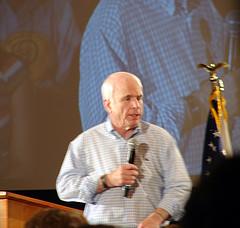|
|
|
Archive for the 'Leading Factors' Category
Wednesday, November 12th, 2008

Now check out a life warning
Your comments—priceless
Don’t miss a post, subscribe via RSS or EMAIL
Image credit: flickr
Posted in Leading Factors, Politics, Wordless Wednesday | 1 Comment »
Thursday, October 30th, 2008
By CandidProf, who teaches physics and astronomy at a state university. He shares his thoughts and experiences teaching today’s students anonymously every other Thursday—anonymously because that’s the only way he can be truly candid. Read all of CandidProf here.
 College is expensive. Students have to pay for tuition, fees, books, school supplies, and all sorts of other expenses. Many years ago, college was still expensive, but at least the average college student could afford to go to college. But tuition, fees and textbooks have increased in price at far more than the inflation rate. Students and parents are understandably upset over this. At many institutions, the tuition goes up every year, sometimes at several times the inflation rate. Many people think that the universities are just raising tuition to be greedy. It isn’t that simple, though. College is expensive. Students have to pay for tuition, fees, books, school supplies, and all sorts of other expenses. Many years ago, college was still expensive, but at least the average college student could afford to go to college. But tuition, fees and textbooks have increased in price at far more than the inflation rate. Students and parents are understandably upset over this. At many institutions, the tuition goes up every year, sometimes at several times the inflation rate. Many people think that the universities are just raising tuition to be greedy. It isn’t that simple, though.
The average student’s tuition does not adequately cover the cost of education. College is not like high school. College professors need to maintain expertise and remain current in their fields of study. That means more than just reading about the subject on the internet. Also, college professors need to be paid. Libraries need to be current, and professional journals are not cheap. Books are not cheap for libraries, either.
State colleges and universities are supposed to be supported by tax dollars. However, state legislatures have cut funding to higher education, reasoning that colleges and universities can make up the difference through tuition. That means that tuition goes up to cover inflation, and then goes up even more to cover the reduction in state funding.
Private institutions rely not only on tuition, but on investments from their endowments to generate operating funds. In today’s economic climate, those endowments are not bringing in much money, so tuition has to rise to compensate.
Then, textbook companies keep coming up with new editions of textbooks. They are pretty proactive killing the used book market, too. I have on occasion tried to adopt an old edition of textbooks when the new editions come out, only to find that the bookstore could not get copies of the old edition. We wound up using the new editions. So much for trying to save my students some money.
As you can imagine, costs quickly spiral upwards too high for most students to be able to afford college. There are some grants and scholarships, but most are for those who have very low incomes.
The wealthy can afford college.
The poor have it paid for them.
The middle class, the bulk of our students, don’t qualify for grants and can’t afford college themselves.
This is where student loans come in. All across the nation, college financial aid offices are advising students to secure student loads. But most of these students are young and have not had any experience with loans. They quickly get in over their heads. Nearly 2/3 of students wind up graduating college in debt. Most owe over $20,000 in loans. Many owe over $50,000 and some students owe nearly $100,000 (if they go from undergraduate to graduate, law or medical school).
This is a serious problem. Students are graduating deep in debt.
Worse, shortly after graduation they have to start paying back their loans, but this is when they are least able to do so. After all, your first job after college normally is not a high paying job (even for highly paid fields). So students graduate with debt, just as they are trying to buy cars, buy houses, start families and do many other things that incur additional debt and expenses.
To add insult to injury, students often have to take more classes than they used to. High schools are turning out students who are not at all prepared for college level work. Close to half of our students require some remedial work in mathematics, reading, and writing. Those remedial classes have tuition, but they do not count towards degrees. This adds a year or more to an undergraduate program and it incurs more tuition, fees and textbook expenses. That is a problem, however, that needs to be fixed at the high school level.
So, what are we to do at the college level? The solution is not to simply force colleges to lower tuition. After all, tuition was raised not out of greed, but as a way to fund the college after state funds and endowments dried up. If states were to fund higher education at the rate that they used to, then tuition would drop. As for textbooks, I’ll leave that to a later post.
What is clear to me is that something needs to be done. We are doing our students a disservice if they are graduating deep in debt. Perhaps our financial aid offices should be working to help students find part-time jobs to fund their education. Perhaps there needs to be more direct government assistance to students in the form of grants.
It is hard to say just what needs to be done. But I see the cost of college getting higher and higher. In fact, it is high enough now that I think that I’d have had trouble affording it and I seriously doubt that I’d have been able to afford graduate school.
There is not an easy fix to this problem. Any fix would require a cohesive and comprehensive plan.
And I simply don’t see that happening.
Your comments—priceless
Don’t miss a post, subscribe via RSS or EMAIL
Image credit
Posted in About Leadership, CandidProf, Leadership's Future, Leading Factors | 7 Comments »
Wednesday, October 29th, 2008

Now see what to do about it
Your comments—priceless
Don’t miss a post, subscribe via RSS or EMAIL
Image credit
Posted in Leading Factors, Wordless Wednesday | No Comments »
Tuesday, October 28th, 2008
By Wes Ball. Wes is a strategic innovation consultant and author of The Alpha Factor – a revolutionary new look at what really creates market dominance and self-sustaining success (Westlyn Publishing, 2008) and writes for Leadership turn every Tuesday. See all his posts here. Wes can be reached at www.ballgroup.com.
Is there really a lending problem? I know several people who doubt it.
One is a local car dealer. He was almost dazed as he related a story to me about selling a used car to a woman who had a bankruptcy five years ago. He sold her a nice car for $27,000. She did not have the first payment she needed to make the deal. Three banks (Bank of America, Citizens Bank, and one other I can’t recall) all offered her a loan for $32,000. That’s on a car that would only give her $22,000 on trade-in, if she sold it back one week after consummating the deal.
I also know another young couple who just purchased a $19,000 van. They had no problem getting a loan despite the fact that they have very low income. The rate was 18.5% – about three times what should be available. When an older and wiser friend challenged them that they could not afford the payments needed, they said, “Well, they must know what they are doing. They offered the loan to us.” The friend helped them sell the car, pay off the debt they still owed on the van, and get them into something they could afford.
So what’s wrong with these scenarios?
In the first case, at least one of those banks is in the midst of getting a getting an infusion of taxpayer cash from the U.S. Department of the Treasury, because they lost so much money on poor-quality loans. In the second case, the justification for making a really bad decision was that the blame was really on someone else. Worse yet, someone helped them get out from under the burden, but it is obvious from talking to them that they really don’t understand what was wrong with their decision.
We’ve just gone through the scariest financial event in my lifetime, but we aren’t through the consequences of banks, mortgage companies, investment companies, investors, consumers, and the U.S. government all thinking they can get away with making really stupid financial decisions because the blame can be cast upon someone else. It’s like watching three year olds pointing fingers at each other and expecting mom to “buy” it.
What is it going to take for us to finally understand that it doesn’t work to either expect someone else to make things right for us when things go bad or to do things that enable those persons making bad decisions to go on making bad decisions?
Isn’t it time that we let people take responsibility for their decisions?
If people want to have the freedom to make decisions for themselves, shouldn’t they also be required to take the consequences of those decisions?
Your comments—priceless
Don’t miss a post, subscribe via RSS or EMAIL
Image credit
Posted in Communication, Ethics, Leading Factors, Politics, Wes Ball | 5 Comments »
Saturday, October 25th, 2008
 What a difference a year makes. Last year Wall Street Journal columnist Alan Murray wrote Revolt in the Boardroom: The New Rules of Power in Corporate America What a difference a year makes. Last year Wall Street Journal columnist Alan Murray wrote Revolt in the Boardroom: The New Rules of Power in Corporate America . (Excerpt) detailing the war between Boards, shareholders and CEOs. . (Excerpt) detailing the war between Boards, shareholders and CEOs.
He remembers the time when CEOs were all-powerful autocrats running top-down organizations under the auspices of Boards comprised friends and colleagues. The came the revolt and CEOs started being dumped right and left.
How large was the turnover tally last year and was it really that different from what it used to be?
Generally speaking, prior to the 1990s CEOs weren’t fired. During the Nineties Boards ousted a few high profile cases, such as GM, IBM, American Express, but by mid-2000 things really started changing and have continued apace—663 in 2004, 1322 in 2005, 1478 in 2006, but ‘only’ 1,356 2007.
Of course, not all were fired, some retired, some took outside offers, but a great number left by, or just before, Board request and some left in a very public perp walk.
By the time the book came out, six years after Enron, most of us thought we’d seen the worst; we believed that governance had changed and that Boards and investor activists had tamed CEO ego.
Many thought that it was a permanent shift in power away from CEOs, but it took only a year to show how inaccurate that analysis was.
It might be true when dealing with felonious intention, but when it comes to “maximizing shareholder returns” it seems like anything legal still goes.
But even slightly out of date, Revolt in the Boardroom is a good read—educational, entertaining and offering some unique insights into the corner office.
Your comments-priceless
Don’t miss a post, subscribe via RSS or EMAIL
Image credit
Posted in About Leadership, Culture, Ethics, Group Dynamics, Leading Factors, Reviews & Recommendations | No Comments »
Friday, October 17th, 2008
Or is it a pyramid?“A Ponzi scheme is a fraudulent investment operation that involves promising or paying abnormally high returns (“profits”) to investors out of the money paid in by subsequent investors, rather than from net revenues generated by any real business.”
“A pyramid scheme is a non-sustainable business model that involves the exchange of money primarily for enrolling other people into the scheme, without any product or service being delivered.”
This is what came to mind after reading CandidProf’s post yesterday; I finally decided that’s it’s both, making is a pyra-Ponzi scheme.
As CP described the situation it’s definitely a pyramid, his college is funded based on how many students are enrolled as are most K-12 schools in this country. Further, lowering standards and focusing only on retaining students in order to continue funding certainly fits the no service being delivered description of a pyramid.
The Ponzi element is seen in high promises from such initiatives as No Child Left Behind, which has done nothing to stem the downward spiral of learning—in fact, it has made it worse.
NY Times Op-Ed Columnist Bob Herbert quotes from a study published in the Notices of the American Mathematical Society that states, “The United States is failing to develop the math skills of both girls and boys, especially among those who could excel at the highest levels, a new study asserts, and girls who do succeed in the field are almost all immigrants or the daughters of immigrants from countries where mathematics is more highly valued.”
He ends by quoting “An article in Monday’s Times spotlighted some of the serious problems that have emerged in the No Child Left Behind law. Among the law’s unintended consequences, as Sam Dillon reported, has been its tendency to “punish” states that “have high academic standards and rigorous tests, which have contributed to an increasing pileup of failed schools.”
After reading CandidProf’s post, my Russian business partner, Nick Mikhailovsky, commented,
“Actually, the average education quality has significantly degraded over here as well. Although the reasons are different the outcome is the same and applies to both basic and higher education.
Our reason is simpler—low salaries in education.
Everyone who needed money or couldn’t bear living in poverty has left education. After 15 years of that, there are almost no good teachers or  college professors left. The old ones retired, and young people aren’t willing to live in poverty when they have plenty of other opportunities and all their life in front of them.” college professors left. The old ones retired, and young people aren’t willing to live in poverty when they have plenty of other opportunities and all their life in front of them.”
Hmmm, Russia seems to be dumbing down by salary, but considering the salaries we pay our teachers we’re trashing US education from the top down and the bottom up.
Your comments—priceless
Don’t miss a post, subscribe via RSS or EMAIL
Image credit
Posted in Leadership's Future, Leading Factors, Leading Stupidities, Personal Development, Politics | No Comments »
Thursday, October 16th, 2008
By CandidProf, who teaches physics and astronomy at a state university, shares his thoughts and experiences teaching today’s students anonymously every Thursday—anonymously because that’s the only way he can be truly candid. Read all of CandidProf here.It’s all about the numbers. Sadly, that is how many college administrators see the students: as numbers.
The college has an enrollment figure. In my state, one of the key measures that they are now implementing to rate college performance is the increase in enrollment figures.
For a long time, as a public institution, we have been funded by how many students are enrolled, so the administration has been actively recruiting students. It has not mattered whether or not the students are ready for college. That was not important. It did not matter if they had the skills to succeed. That was not important. Whether or not they enrolled was important, not whether or not they learned anything while here, nor even if they passed any of their classes.
Another key measure for the state is in access of college to minorities and Hispanics. We are advertising in Spanish. The college’s web site can be viewed in Spanish. The registration can be done in Spanish. But all of the classes are in English.
Students who don’t know English are up a creek. They have little hope of passing the classes once they get here. No matter. They enrolled, they were counted by the state, and that was all that mattered.
Going hand-in-hand with enrollment is retention. College administrators go to conferences with other college administrators, and they all talk about retention policies.
The idea is that getting students to enroll is not sufficient. They want them to enroll again next semester. So, if they flunk out, then they won’t be enrolling again.
The first strategy used by many colleges is to simply change the rules on what constitutes flunking out. When I was a student, a single F or D, or too many C’s, was sufficient to get a student put on academic probation. If you repeated a bad semester, then you were placed on academic suspension. That wasn’t meant so much as punishment, but rather to give you time to reassess your educational goals and strategies. I never had to go through that, but I knew some students who did.
Now, you can fail a class every semester, and have a whole semester of D’s and C’s, and keep that up for semester after semester. A depressing number of our students graduate with a GPA of less than 2.0. But the students keep signing up for classes and that is all that counts.
The next step in retention is to put pressure on faculty to give higher grades. After all, the administrators reason that if students get too many poor grades, they might get discouraged and drop out. If they drop out, then they won’t be registering for classes and that means, of course, that there will be less state funding for the college. So faculty are encouraged not to grade too harshly and to give higher grades.
This has been going on in the K-12 education for years, but it is now becoming more common in colleges. I have a number of colleagues who are teaching in a climate of that sort. Many faculty just give up and quit upholding standards. They just give out grades. The students don’t learn. We have a few part time faculty here who do that, too, because that is expected at other places in the area where they teach part time.
But students who take the classes of a faculty member who just gives out grades without the students learning seldom do well in the follow-up classes.
Worse, this strategy makes a college degree pretty much worthless.
Holding to standards is hard, particularly when others don’t hold to those standards.
Holding to standards is hard when funding is tied to numbers that can be improved by relaxing those standards.
But an effective leader will hold standards, even if it is the hard thing to do.
I see this getting worse. My state is now looking to change the funding formula for its public colleges and universities. Rather than giving money for the number of students enrolled at the beginning of the semester, they are looking to fund the number of students enrolled at the end of the semester.
That changes things. It means that simply getting students to sign up is not enough. Now, we need to keep them in the class all semester. It is pretty obvious that there will be extreme pressure on faculty to limit the students dropping.
That means making the classes easier.
That means giving up on tough and difficult standards and setting the bar as low as possible to make it easy for students to pass without ever having to do anything.
That means giving up on teaching.
And this is what is coming down the pike from state legislatures all over the country. They have done this sort of thing in K-12 education, making a high school diploma pretty much worthless.
Now they are working to make an undergraduate college degree worthless as well.
A lot of faculty are planning on retiring when these changes are made. I have a few years to go until retirement, and I am not looking forward to what I see in our future.
Your comments—priceless
Don’t miss a post, subscribe via RSS or EMAIL
Image credit
Posted in CandidProf, Leadership's Future, Leading Factors, Leading Stupidities, Politics | 1 Comment »
Tuesday, October 14th, 2008
 It is the rare leader who leads beyond what is expected of him.Those who do are often labeled as unfit to lead and dismissed. It is the rare leader who leads beyond what is expected of him.Those who do are often labeled as unfit to lead and dismissed.
There are not that many examples of such rare leaders. General MacArthur was certainly one. He stood up to President Truman, who was quite happy to play at war in Korea without winning it, which cost many thousands of lives for no real gain. Gen. MacArthur’s dismissal by the President was a terrible blow to his honorable record of service throughout World War II, an embarrassment to the Army he commanded, and the beginning of an approach to conflict that has plagued us ever since. But his dismissal was also completely rational, because he was not working to expectations.
Leaders, who wish to keep their jobs, work to satisfy expectations.
Understanding this is critical to our understanding of what has recently happened in the financial and mortgage markets.
The key here is understanding that leaders lead only with the support of their constituency (i.e. stockholders or boards of directors in the case of corporate leaders or voters in the case of politicians). A leader cannot get away with major strategic direction that his constituency does not approve, such as running full-bore into selling sub-prime mortgages. This is not a matter of a few rogue leaders who ran ahead of their organizations without oversight or accountability. Every head of every organization caught with their mortgages down was in that position with the full knowledge and support of his constituency. That includes Wall Street, banks, and both GSEs (Fannie Mae and Freddie Mac).
Even the criminal actions of overstating balance sheets in order to gain the huge bonuses being offered had to be done with the knowledge and approval of a constituency. For instance, Franklin Raines of Fannie Mae could not have gotten away with overstating his balance sheet repeatedly to gain the $90 million he earned over 6 years (as the organization was actually failing) without both his board and the Congressional oversight committee assigned to watch his actions approving of it. In fact, in 2004, when Armando Falcon, the chief regulator who “blew the whistle” on these shenanigans, went before the Congressional oversight committee, he was all but tarred and feathered for his efforts. No one seemed interested in hearing about anything untoward, because the objective of increasing mortgages to low-income families was being addressed. End of subject.
Corporate executives also are being whipped for the “outrageous” sums of money they earn, primarily as a reward for pushing stock prices ever higher. As I have written many times, the tactics they use to accomplish this are more often than not the death-knoll for the long-term success of the organization, but that doesn’t stop the board of directors and stockholders from applauding their efforts.
The problem comes down to, “Who really cares before the damage starts to show?” Top executives are not stupid. Neither are politicians (the few years I worked with Washington politicians proved to me that almost all believe they have the best interests of their constituency in mind). They know exactly where their support comes from and what that constituency wants from them. Despite all the worries about sub-prime mortgages that were voiced over most of the past decade, no one really cared.
Why? Because expectations were being met. The deceit was in hiding the truth from the constituency. What made the sub-prime fiasco possible was the fact that risk was being “diluted.” Every time a package of mortgages was sold to investors, the real hidden risks were lost in the mass. That effectively removed the effect of what would have been the most vocal constituency: those who would have spoken up by keeping their checkbooks closed had they known the real risk.
The only constituency that really knew what was going on in most cases was the one gaining from it.
The same thing is going on in corporations across the country. Decisions about how companies are being run are coming from the wrong constituency. The expectations are being driven by boards of directors and stockholders, who care little about the long-term health of the company as long as short-term gains are good enough to increase their personal portfolios.
So, what is the answer? Can we expect companies to survive and do the job for which they were created, i.e. job and wealth creation for those who invest their time and money into it, when persons with no long-term interest are defining the expectations for corporate executives? Can we expect government-overseen organizations or programs to have positive long-term effects, if those defining expectations are only interested in narrow outcomes that can create far greater damage but that provide personal gain for them (even if it is only in terms of pandering to the base desires of their constituencies)?
Leaders lead to expectations. Isn’t it time we started setting expectations that don’t just “use” an organization for personal success and instead start expecting long-term success that builds the organization creating that success?
We are being asked to take a greater personal role in addressing climate change. Can’t we also take a greater role in demanding corporate responsibility? If not, we may be witnessing the end of the independently-run corporate model in America.
We are delegating far too many decisions that affect us as long as things seem to be “going right” (no matter how obvious the risks are), and then expecting someone else to make things right. Isn’t now the time for the real constituency to stand up and make its voice known?
We can do it through our investing. We can do it through our voting and regular conversations with our political representatives. We can do it in through an unwillingness to let others speak for us, while we sit back and demand that everything go perfectly right for us.
How would you address this without giving even more control to a constituency that would drive the wrong expectations?
Your comments—priceless
Don’t miss a post, subscribe via RSS or EMAIL
Posted in About Leadership, Ethics, Leadership Choice, Leadership Turn Odd Bits, Leading Factors, Leading Stupidities, management, Politics, Wes Ball, What Leaders DO | 2 Comments »
Friday, October 10th, 2008
Wednesday Phil Gerbyshak over at Slacker Manager shared his application of Edward Brown’s description of the two dominant leadership models, Charismatic Leadership (often described as arousing the emotions of the populous through imagery and poetic prose) and Traditional Leadership (Often described as operations-centric and unilateral while courting consensus building) and analyzed Obama and McCain in that light.
I thought I’d add to that with a guest post from Korn/Ferry International’s Kevin Cashman and Ken Brousseau (detailed bios at end of post), in which they apply their CEO assessment, expertise and constructs to the Presidential candidates.
Note: The candidates are discussed in random order and reflects no preference by the authors.
An Expert Analysis Of Our Presidential Candidates’ Executive Leadership
 
Voters commonly cast their ballots based on the critical issues and policies, but what about the equally crucial assessment of a candidate’s leadership strengths and approaches?
- Who is the leader beneath the speeches, policies and ads?
- How would experts describe the unique leadership styles of Barrack Obama and John McCain if they were being assessed for a global CEO position?
Two leadership authorities from one of the world’s largest talent management firms, Korn/Ferry International, point to four critical and differentiating facets of Obama and McCain’s leadership:
- decision-making styles;
- emotional temperaments;
- learning agility; and
- power-of-voice versus power-of-connection.
Overall, Cashman and Brousseau say that
- McCain’s strengths appear to be action-orientation, adherence to principle and a fiery tenacity to achieving results, whereas
- Obama tends to demonstrate exceptional learning agility, collaboration and is calmer under pressure.
1. Decision-Making Styles – Cashman and Brousseau assert that both candidates are principled decision-makers, but differ in their propensities to quickly or analytically make decisions and hone in on single versus multiple courses of action. Korn/Ferry’s research (see this Harvard Business Review article) at shows that those unable to lead in a “complex style” have low likelihoods of succeeding in their positions, yet once they’ve risen to a top level, it’s possible to succeed with multiple approaches. They observe:
- McCain is a more uni-focused thinker who focuses on one key principle or goal and tenaciously holds to a particular action rather than changing positions. When not in action-mode, he shifts to a more complex style that’s both analytic and uni-focused, efficiently studying the facts, and making and sticking to what he senses is the best decision.
- Obama also operates in the complex mode, but more often uses a creative and integrative style that is analytic and more open to alternate possibilities. Before making a judgment, he studies an extensive array of information and options, then gradually forms a strategy combining multiple objectives, actions and viewpoints.
2. Emotional Temperaments – The ability to manage the emotions of one’s self and those around them is a defining aspect of leadership at any level.
- When principles are challenged or threatened, McCain seems to be more emotive and combative to win the day. Achieving high performance works best for him in a high-octane pace where things are very active.
- Obama tends to maintain equanimity and gets introspective to sort out the best solutions to win, asking his staff to provide him with some reflective time each day. His high performance is achieved by reflecting, synthesizing and collaborating.
3. Leadership Agility and Ability to Deal with Ambiguity -The key leadership competency in shortest supply is the ability to deal with ambiguity, according to the research of Korn/Ferry and others and supported by past Presidents who’ve described the job as “everything happening all at once.” Though we often dub political leaders who change their positions as wishy-washy, Cashman and Brousseau say that can be a sign of agility, as good leaders summon past lessons and observations to reframe thinking in first-time contexts or changing global environments. Agility – found to be much more predictive of potential and success than raw intelligence – has components related to mental, people, results and change.
- Obama demonstrates exceptional mental agility and has proclivity for dealing with change and people, but critics may question if his results agility on a large-scale have been sufficiently demonstrated.
- McCain, in contrast, shows a strong results orientation and a measure of mental agility, but his history of working amid volatility and commitment to tradition may call his agility with people and change into question.
4. Exerting Power-of-Voice or Power-of-Connection – Cashman and Brousseau say that many leaders can be understood as either heroic leaders who assert their power-of-voice or more interpersonally inclined leaders who employ power-of-connection. The key is being able to exercise the weaker, non-default area. According to research by Zenger and Folkman, leaders who excel in people or results only, reach the 90th percentile of leadership effectiveness nine or 13 percent of the time, but those who possess both reach that level of success in two-thirds of instances.
- McCain, as someone who forcefully asserts for results, best typifies the heroic “I” type of leader, who leverages personal influence to impact results. The downside can be too much drive and not enough relational connection.
- Obama and his collaborative approach characterize “We” leaders, who leverage collaboration, relationship and synergy to get results. In crisis situations, however, sometimes more “I” is required.
The leadership experts say Obama fits the overall archetype of a “magician” leader, someone who blends ideas and people to produce new solutions to unsolved problems.
McCain, on the other hand, is more of the traditional “warrior” leader, bringing about results through force of will or assertion with little fear of adversarial relationships or situations.
I’m no expert, but it seems to me that we’re more in need of a magician who “blends ideas to produce new solutions” than a warrior who applies “force of will.”
It seems to me that most of the “leaders” who crashed their companies on the rocks, as well as the current Administration, either are, or have a strong leaning towards, the warrior model.
I’m tired of “I” leaders proclaiming their visions, unwilling to brook any kind of disagreement.
I (we?) can only hope that the calamities we’re facing foster a stronger application of “we”—in both politics and business
About the authors:
Kevin Cashman, author of the newly expanded book Leadership from the Inside Out , founded LeaderSource, a Minneapolis-based international leadership development, executive coaching and team effectiveness consultancy that joined with Korn/Ferry International in 2006. Leadership from the Inside Out, available in second edition in September, was named the #1 best-selling business book of 2000 by CEO-READ and one of the top 20 best-selling business books of the decade. Over the past 25+ years, Cashman and his team have coached thousands of senior executives and teams to enhance performance. , founded LeaderSource, a Minneapolis-based international leadership development, executive coaching and team effectiveness consultancy that joined with Korn/Ferry International in 2006. Leadership from the Inside Out, available in second edition in September, was named the #1 best-selling business book of 2000 by CEO-READ and one of the top 20 best-selling business books of the decade. Over the past 25+ years, Cashman and his team have coached thousands of senior executives and teams to enhance performance.
Kenneth Brousseau, Ph.D., is CEO and co-founder of Decision Dynamics LLC, a firm specializing in behavior profiling and human resource systems design. Prior to forming Decision Dynamics, he served as a management and organization professor at the University of Southern California Graduate School of Business Administration. Dr. Brousseau specializes in behavioral assessment systems for purposes of employee selection, organizational development and career management. He is coauthor of The Dynamic Decision Maker, and he has authored articles on career development, work system design, team development and organizational design in publications such as Harvard Business Review, the Journal of Applied Psychology and the Academy of Management Executive.
Your comments—priceless
Don’t miss a post, subscribe via RSS or EMAIL
Image credit: Obama, McCain
Posted in About Leadership, Change, Communication, Culture, Followers, Leadership Skills, Leading Factors, management, Politics | 3 Comments »
Friday, October 3rd, 2008
 Leadership, oh leadership. Wherefore art thou, oh leadership?What does this list have in common? Leadership, oh leadership. Wherefore art thou, oh leadership?What does this list have in common?
Leadership. Each person on this list has been held up as an example of leadership; lauded by the gurus of leadership for their vision, skill at articulating it and ability to attract followers.
- Alan Fishman, Washington Mutual
- Angelo Mozilo, Countrywide
- Bruce Karatz, KB Homes
- Chuck Prince Citigroup
- Douglas Ivester, Coca-Cola
- Frank Newman, Bankers Trust
- Franklin Raines Fannie Mae
- Gregory Parseghian, Freddie Mac
- Hank McKinnell, Pfizer
- James Cayne, Bear Stearns
- John Mack, Morgan Stanley
- Ken Thompson, Wachovia
- Kerry Killiger, Washington Mututal
- Lloyd Blankfein, Goldman
- Michael Ovitz, Disney
- Philip Purcell, Morgan Stanley
- Richard Fuld, Lehman
- Richard Grasso, New York Stock Exchange
- Robert Nardelli, Home Depot
- Stanley O’Neal, Merril Lynch
- Stephen Hilbert, Conseco
What else does this list have in common? Over the last 5 years every one of them has been ousted from their role.
The majority of their visions helped architect the current financial mess.
Oh yeah, and their parachutes ranged from gold to diamond-encrusted platinum. (Payouts listed here and here)
Take me to your leader.
Your comments—priceless
Don’t miss a post, subscribe via RSS or EMAIL
Image credit: greyman CC license
Posted in About Leadership, Communication, Culture, Ethics, Leaders Who DON'T, Leading Factors | 1 Comment »
|
 Subscribe to
Subscribe to
MAPping Company Success
About Miki 
Clarify your exec summary, website, etc.
Have a quick question or just want to chat? Feel free to write or call me at 360.335.8054
The 12 Ingredients of a Fillable Req
CheatSheet for InterviewERS
CheatSheet for InterviewEEs™
Give your mind a rest. Here are 4 quick ways to get rid of kinks, break a logjam or juice your creativity!
Creative mousing
Bubblewrap!
Animal innovation
Brain teaser
The latest disaster is here at home; donate to the East Coast recovery efforts now!
Text REDCROSS to 90999 to make a $10 donation or call 00.733.2767. $10 really really does make a difference and you'll never miss it.
And always donate what you can whenever you can
The following accept cash and in-kind donations: Doctors Without Borders, UNICEF, Red Cross, World Food Program, Save the Children
*/
?>About Miki
About KG
Clarify your exec summary, website, marketing collateral, etc.
Have a question or just want to chat @ no cost? Feel free to write
Download useful assistance now.
Entrepreneurs face difficulties that are hard for most people to imagine, let alone understand. You can find anonymous help and connections that do understand at 7 cups of tea.
Crises never end.
$10 really does make a difference and you’ll never miss it,
while $10 a month has exponential power.
Always donate what you can whenever you can.
The following accept cash and in-kind donations:
|

